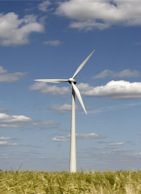
Nuclear power has been been used to produce electricity for more than four decades, beginning with the Shippingport nuclear power plant in 1957. Today there are 104 nuclear power plants in the United States generating some 60 billion kilowatt hours per year of electricity. There have been no deaths from radiation in more than 40 years of American nuclear plant operations. Even considering the “catastrophe” at Three Mile Island, there has not been a single case of injury to any member of the public. (There were fatalities at the Russian Chernobyl plant, but that plant was radically different from an American nuclear power plant. It did not even have a containment structured around the nuclear reactor.)
How about wind power? How does it fare compared to the perfect record of the American nuclear power industry? Believe it or not, there is an organization, the Caithness Windfarm Information Forum, that keeps data on wind-power-related accidents and/or design problems. Caithness is based in Great Britain, where homeowners have already grown tired of the noise and other wind-turbine-generated problems. Their “Summary of Wind Turbine Accident Data to 31 December 2008” reports 41 worker fatalities. Most, not unexpectedly, were from falling as they are typically working on turbines some thirty stories above the ground. In addition, Caithness attributed the deaths of 16 members of the public to wind-turbine accidents.
A summary of accidents includes:
• 139 incidents of blade failure. Failed blades have been known to travel over a quarter mile, and that is from turbines much smaller than those being manufactured today. This type of accident has caused some European countries to require a minimum distance of about one mile (2 km) between occupied housing and wind turbines.
•110 incidents of fire. When a wind turbine fire occurs, the local fire departments (without 30-story ladder trucks) can do little but watch. This isn’t a problem unless the wind is blowing sufficiently to scatter the debris into dry fields or woodlands — or maybe onto your roof.
• 60 incidents of structural failure. This includes turbine failure and tower collapse failures. While not now a problem for the public — except having to gaze upon at a bent-over wind turbine — it may well become one as governments, under pressure from environmental activists, encourage marginal- and hastily-sited wind projects in urban areas where such an accident could kill and maim.
• 24 incidents of “ice throw” with human injury. These data may be a small fraction of actual incidences, with 880 icing events reported in a 13-year period for Germany alone.
Why these fatalities for wind compared to none for the American nuclear power industry? Nuclear energy comes from a reactor core about the size of a living room where it can be monitored and contained in-depth. It would take 2,000 30-story tall wind turbines to produce the power of a typical nuclear plant, assuming 90 percent and 30 percent capacity factors. How many accidents would you expect when building 2,000 30-story turbine generators as compared to pouring concrete for a single containment building of a few thousand square feet?
But the deaths and injuries resulting from wind turbine construction and operation will be dwarfed by the carnage certain to occur in California Governor Arnold Schwarzenegger’s “million solar roofs plant” actually comes to fruition? Falls, currently the second largest cause of accidental deaths after auto accidents and five times the rate from fires, will no doubt take a sizable jump as tens of thousands of amateur installers take to the roofs. And remember, solar voltaic cells must be cleaned regularly else they rapidly lose their already poor efficiencies.
Environmental accidents would have more credibility if they presented the full story on “non- renewables” such as wind and solar power. Of course, if they did, and if they at the same time claimed that we must go wind as opposed to nuclear, theyíd be laughed out of town.
March 6, 2009 Addendum: The original intent of this article was to point out the existence of a group, the Caithness Windfarm Information Forum,that kept track of accidents and deaths related to construction and operation of wind turbines. I was amazed that such a group existed and was so knowledgeable about the subject. But being unabashedly pro-nuclear, I couldnít resist pointing out the excellent safety record in the nuclear power generation industry.
I had given it the sarcastic working title of “That Safe Renewable Energy.” Now that I look at it, however, the article indeed looks like a comparison of the safety records. As pointed out by comments below, however, it is not a fair comparison since the wind data was worldwide and the nuclear power stats were from the United States alone. As noted by one commentator, it does a disservice to the nuclear power industry as it appears to be spinning data in favor of nuclear power when such spinning is unnecessary.
Then too, as mentioned out by another commentator, the accident and death rates should be put in terms of relative amounts of power generated — a good research topic for another day. My apologies for not taking all of this into consideration, especially since my raison d’etre is bringing the truth about energy matters to the readers of The New American.
Photo: Creative Commons CC-BY-SA-2.5



